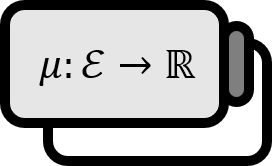Dinkin's Pi-Lambda Theorem
Theorem
If the pi system $\mathcal{P}$ is a subset of the lambda system $\mathcal{L}$, then there exists a sigma field $\sigma ( \mathcal{P} )$ that satisfies $\mathcal{P} \subset \sigma ( \mathcal{P} ) \subset \mathcal{L}$.
- $\sigma ( \mathcal{P} )$ represents the smallest sigma field that contains all elements of $\mathcal{P}$.
Explanation
At first glance, the statement might look rather simple, but as with such theorems, its proof is quite long and complicated. Let’s think about what roles the pi system $\mathcal{P}$ and the lambda system $\mathcal{L}$ play here.
- The following is called a $\pi$-system if it satisfies $$ A, B \in \mathcal{P} \implies A \cap B \in \mathcal{P} $$
- The following are conditions that a $\lambda$-system meets if it satisfies:
- (i): $\emptyset \in \mathcal{L}$
- (ii): $A \in \mathcal{L} \implies A^{c} \in \mathcal{L}$
- (iii): For all $i \ne j$, when $\displaystyle A_{i} \cap A_{j} = \emptyset$, then $\displaystyle \left\{ A_{n} \right\}_{n \in \mathbb{N}} \subset \mathcal{L} \implies \bigcup_{n \in \mathbb{N}} A_{n} \in \mathcal{L}$
Measure theory, as the name suggests, is a theory about measuring things, so we inevitably have to consider measurable spaces and, whatever we do, there needs to be a sigma field. However, finding the exact sigma field suitable for a given problem might not be as easy as it seems. If there’s a constraint that this problem’s sigma field should be larger than the pi system but not larger than the lambda system, then through this theorem, one could obtain a specific sigma field $\sigma ( \mathcal{P} )$.
This means that when facing a daunting problem of finding a sigma field, one can start by creating a relatively easier-to-construct pi system. The lambda system must be built to include this simpler pi system, which process is typically more specific and easier than ‘just finding some sigma field’.
